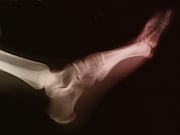Public health efforts to promote healthy diet and prevent obesity might cut gout cases, authors say
WEDNESDAY, Sept. 18, 2019 (HealthDay News) — Four modifiable risk factors — body mass index (BMI), the Dietary Approaches to Stop Hypertension (DASH) diet, alcohol use, and diuretic use — could individually account for a notable proportion of hyperuricemia and possibly gout cases, according to a study published online Sept. 4 in Arthritis & Rheumatology.
Hyon K. Choi, M.D., Dr.P.H., from Massachusetts General Hospital in Boston, and colleagues used data from 14,624 community-dwelling adults to estimate the prevalence of hyperuricemia as well as differences by body mass index (≥25 kg/m²), alcohol intake, nonadherence to a DASH-style diet, and diuretic use.
The researchers found that BMI, alcohol intake, adherence to a DASH-style diet, and diuretic use were all associated in a dose-response manner with serum urate levels and the presence of hyperuricemia. The prevalence of hyperuricemia cases was 60 percent for overweight/obesity, 82 percent for nonadherence to a DASH-style diet, 48 percent for alcohol use, and 8 percent for diuretic use. The population-attributable risks by each factor were 44, 9, 8, and 12 percent, respectively, with corresponding variances explained by the four factors of 8.9, 0.1, 0.5, and 5.0 percent. With exposure prevalences nearing 100 percent, variance neared zero in the simulation.
“These findings suggest that modifiable factors have an important place in the primary prevention of hyperuricemia and likely gout,” Choi said in a statement. “Public health efforts should promote individual behavioral changes as well as broader policy changes targeting the obesogenic food environment.”
Copyright © 2019 HealthDay. All rights reserved.








